
МІНІСТЕРСТВО ОСВІТИ УКРАЇНИ
НАЦІОНАЛЬНИЙ ТЕХНІЧНИЙ УНІВЕРСИТЕТ УКРАЇНИ
«КИЇВСЬКИЙ ПОЛІТЕХНІЧНИЙ ІНСТИТУТ»
НАВЧАЛЬНИЙ ПОСІБНИК
для практичного оволодіння навичками читання, монологічного
та діалогічного мовлення
для занять з англійської мови
для студентів І курсу технічних спеціальностей
КИЇВ НТУУ «КПІ» 2009
НАЦІОНАЛЬНИЙ ТЕХНІЧНИЙ УНІВЕРСИТЕТ УКРАЇНИ
«КИЇВСЬКИЙ ПОЛІТЕХНІЧНИЙ ІНСТИТУТ»
НАВЧАЛЬНИЙ ПОСІБНИК
для практичного оволодіння навичками читання, монологічного
та діалогічного мовлення
для занять з англійської мови
для студентів І курсу технічних спеціальностей
Затверджено
на засіданні кафедри англійської
мови технічного спрямування №1
Протокол № 9 від 12.06.08
Київ нтуу «кпі» 2009
Навчальний посібник для практичного оволодіння навичками читання, монологічного та діалогічного мовлення для занять з англійської мови для студентів технічних спеціальностей/
Упорядн. В.В. Чмель. –К,: НТУУ «КПІ».70с. – Англ. і укр.. мова.
Упорядник: В.В. Чмель
Відповідальний за випуск Н.С. Саєнко
Рецензенти: С.І. Сидоренко
Т.Г. Семигінівська
Навчальний посібник укладено відповідно до програми і спрямовано на розвиток навичок читання, монологічного та діалогічного мовлення у студентів технічних спеціальностей.
Цю роботу належить використовувати як базову для вивчення студентами загальноосвітніх тем, удосконалення навичок читання, монологічного та діалогічного мовлення.
Видання складається з семи окремих тем, кожна з яких вміщує додаткову лексику, текст для читання, запитання до тексту, вправи для перекладу, а також вправи на розвиток мовленнєвих навичок студентів.
Виконання студентами завдань посібника сприяє інтенсифікації процесу навчання іноземній мові, підвищує результативність навчання діалогічному та монологічному мовленню та зацікавленість студентів у розвитку навичок читання.
THE NATIONAL TECHNICAL UNIVERSITY OF UKRAINE
‘KYIV POLYTECHNIC INSTITUTE’
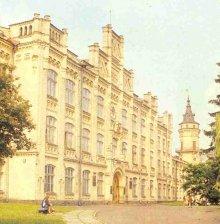
Prominent – видатний, відомий,
electric welding – електрозварювання,
helicopter(s) – гелікоптер,
satellites – штучний супутник,
to grant – давати, дарувати,
self-governing (autonomous) – автономний, самокерований
higher State educational establishment – вищий державний учбовий заклад,
wide authorities – широкі повноваження,
determination – визначення, вибір,
social-economic conditions – соціально-економічні умови,
to create – створювати,
fundamental and applied research – фундаментальні (основні) та прикладні дослідження,
pedagogical (teaching) staff – педагогічний (викладацький) склад працівників,
to allow – дозволяти,
bachelor – бакалавр,
master – магістр,
up-to-date level – сучасний рівень,
assistant – асистент, помічник,
personnel –персонал, штат працівників,
to cover a great deal of problems – охопити велику частину проблем,
selection – відбір,
enrolment – набір до учбового закладу,
to confer – присуджувати науковий ступінь,
skill – майстерність, уміння,
requalification – перекваліфікація,
to seek – шукати,
the humanities – гуманітарні науки
correspond to – відповідати чому-небудь,
opportunity- можливість,
Integration – інтеграція, об’єднання,
module and rating technology - модульна та рейтингова технологія.
to supply – постачати, задовольняти,
exchange of students – обмін студентами,
postgraduate(s) – аспірант(и),
to inhabit – жити, мешкати, населяти,
hostel – студентський гуртожиток
married students – одружені студенти,
swimming pool – басейн для плавання.
gymnasium – спортивний зал,
rehabilitation centre – реабілітаційний центр,
sports ground – спортивний майданчик.
repair shop – майстерня.
to be available – бути доступним,
board and lodging house – квартира з харчуванням, повний пансіон,
health camp – оздоровчий табір,
to provide – постачати, забезпечувати,
necessary – необхідний, потрібний.
The Kyiv Polytechnic Institute was founded in 1898. The idea of its creation united such outstanding scientists of that time as V. L. Kirpichov,
M. Y. Zhukovsky, K. O. Timiryazyev. The President of the First Examining Board in chemistry faculty was Dmitry Mendeleyev. The Institute had only four departments then, among them: mechanical, chemical, engineering and agricultural. A great number of prominent people worked and studied there: Y. P. Paton, the founder of electric welding, I. Sikorsky, the inventor of helicopters, S. P. Korolyov, the designer of the first satellites and spaceships in the world.
Academician Stepan Timoshenko, one of the founders of the Ukrainian Academy of sciences, the elected member of the academies of sciences in Ukraine, Russia, Poland, France, the USA, Italy, American Philosopher‘s society, Royal society of London and the honorary doctorate of the Universities of Michigan, Zurich, Glasgow, Munich, Bologna, Zagreb, Turin, the holder of the most prestigious awards in science was one of the most brilliant lecturers and professors at the strength of materials faculty of the KPI. Timoshenko’s article published in the Kyiv Polytechnic News Bulletin found a wide application in shipbuilding. In fact, the steel plates used in the ships, were tested for tensile strength based on Timoshenko formulae. Timoshenko’s textbook on the strength of materials was translated into many foreign languages and many engineers used it and will use it in their studies. In 1911 Timoshenko was awarded the Zhuravsky Award, which was awarded only once every decade for the best work in construction mechanics. In 1922 Timoshenko was awarded the Lever medal by Franklin Institute for his work on suspension bridges in New York. The same year he presented his research on crank shafts at the American society of engineers.
There is a museum of History of the KPI, where the students and guests may get acquainted with its past and development of engineering in Ukraine.
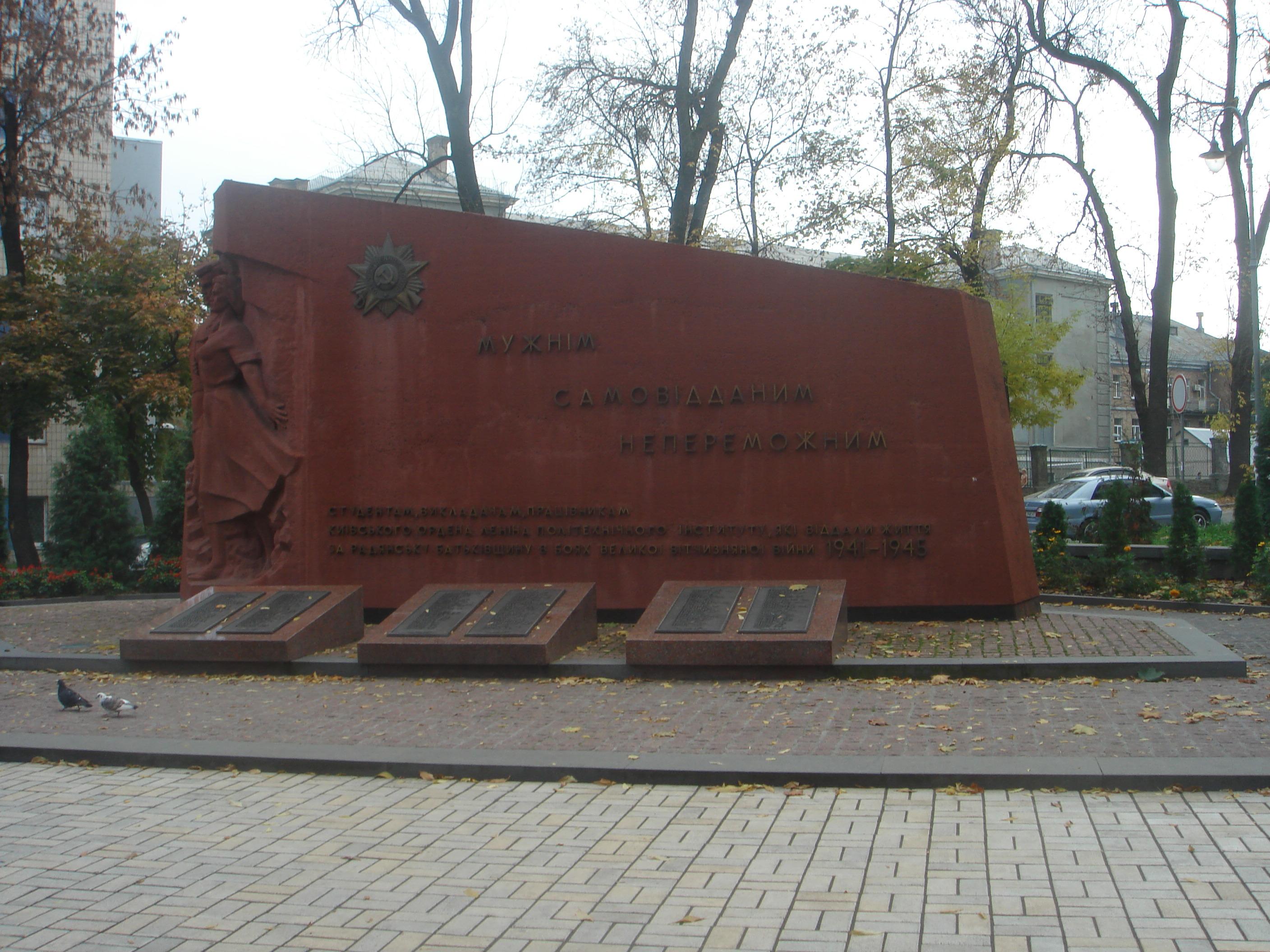
The KPI wrote a glorious page in the history of the Great Patriotic War. During the Second World War (1941-1945) the teachers and students of the KPI glorified their University, giving their lives for the liberation of our Motherland. There is a monument to them at the entrance of the KPI park. According to tradition on the 1st of September (the beginning of the new academic year), a special delegation of the first-year students, professors and teachers of the KPI come to the monument to lay flowers and express their gratitude to the heroes who sacrificed their lives defending their Homeland.
After the War the KPI had to overcome many difficulties. In fact, it had to begin its life anew. Since then, the KPI had made great progress. The teaching staff of the KPI consists of highly qualified teachers, professors and scientists. They do their best to provide the students with all-round scientific and technical education.
Engineers-graduates of the KPI work all over Ukraine and abroad, introducing the latest achievements of science and technology. Many graduates and postgraduates of the KPI have become famous scientists.
At present there are 21,932 full-time students, 1,436 part-time students, 3,657 students by correspondence, 1,068 foreign students from fifty countries of the world, 482 post graduates, including 80 foreigners, and 27 doctorates (total more than 28,000 students).
Today there are 21 faculties and 9 institutes which train specialists in such fields of technology as power engineering, radio, electronics, computing, automation, telecommunications, etc. They are: Energy Saving and Energy Management Institute, Institute of Physics and Technology, Institute of Mechanical Engineering, Military Institute of Telecommunications and Information Technology, Institute of Telecommunication Systems, Aircraft and Space Systems Faculty, Applied Mathematics Faculty, Chemical Engineering Faculty, Chemical Technology Faculty, Electronics Faculty, Welding Faculty, Biotechnology Faculty, Sociology Faculty, Physical Training and Sports Faculty, Radio Engineering Faculty, Management and Marketing Faculty, Publishing Faculty, Linguistics Faculty, Law Faculty, Heat Power Engineering Faculty, Precision Instruments Faculty, Information and Computer Engineering Faculty, teaching and scientific complex ‘Institute of Applied and System Analysis’, scientific-research institutes, laboratories, construction bureaus, publishing centre ‘Polytechnika’, engineering and other centres, scientific and technological parks ‘Kyiv Polytechnika’ and others.
They offer a great number of training programs: automation and electric drive, mining deposits of useful minerals, mine and underground construction, ecology and environmental protection, electromechanical systems, hydraulic and pneumatic machines, boilers and reactors, electric power stations, heat power stations, computer systems and networks, etc.
In accordance with the Decrees of the President of Ukraine dated April 8, 1995 #289 and August 30, 2004 #1023 Kyiv Polytechnic Institute was granted with the name the National Technical University of Ukraine “Kyiv Polytechnic Institute” and got the Status of the National self-governing (autonomous) higher State educational establishment of research type with wide authorities in determination of the content of the higher education, its forms and ways of activity. The University is accredited according to the status of higher educational establishment of the 4th level and has the right to provide education for highly-qualified specialists. The National Technical University of Ukraine “Kyiv Polytechnic Institute” is one of the oldest higher technical institutes of Ukraine and has its own historical traditions, works actively in the new social-economic conditions which are being created in the country. But as it was before, its main tasks are training specialists for industry, scientific pedagogical specialists for the development of scientific-technical potential of Ukraine, the development of fundamental and applied research as well as in the traditional directions (fields) of science and technology so in the newest directions using the innovatory model.
Scientific and innovatory activity of the university is inseparable part of its educational activity that gives possibility to train specialists on the basis of the latest achievements in science and technology, to develop new technical means of education according to the results of scientific investigations, to involve students into scientific and research work of basic departments and engineering centres, to carry out fundamental and applied scientific investigations to create new technics, innovatory technologies and new materials, to co-operate with academic and branch scientific organizations to solve important technical and scientific tasks, to produce experimental samples and equipment and appliances for different purposes, to provide scientific and technical expertise in the market, etc.
The creative potential of the pedagogical and scientific staff of the university, material-technical and laboratory basis, wide contacts with industrial enterprises, research institutions of the Academy of Sciences of Ukraine, traditional connections with universities abroad allow to train bachelors, engineers, masters, candidates (of sciences) and doctors of sciences, to carry out scientific research work at the up-to-date level. Self-governing in educational activity of the teaching staff of NTUU “KPI”, consisting of more than 2000 professors, assistants and other personnel, allows to cover a great deal of problems: training, test selection and enrolment of young people who want to become students, training the highly educated specialists, postgraduates, conferring the Candidate’s and Doctor’s degrees, raising the level of skill and requalification of both Ukrainian and foreign specialists.
Following the best traditions of the higher education, the teaching staff of our university is seeking advanced methods of training, inviting as lecturers the well-known scientists of Ukraine as well as professors of leading foreign universities working with NTUU “KPI”.
After getting the highest State status of the National Technical University of Ukraine, specialities in economy and the humanities that correspond to the modern needs of the country as well as new engineering specialities are developed. This creates opportunity for getting second speciality.
New situation in Ukraine has created new possibilities for NTUU “KPI” integration into the world higher education system to take part in the international educational programs. Module and rating technology of study with full methodical supplying has been started.
At present NTUU ”KPI” cooperates with almost 30 technical universities of many countries, trains bachelors, masters, candidates and doctors of sciences for about 100 states of the world. The exchange of students is also carried out according to the agreements on cooperation with many higher educational establishments of the USA, Canada and Western Europe. About 1500 foreign citizens from more than 42 countries study at the University nowadays.
More than 42 thousand students and postgraduates of NTUU “KPI” inhabit the University Campus. Its structures make up the complex of 28 academic and laboratory structures and blocks of research institutes, 22 hostels (3 for married students), sports complex with 2 swimming pools, gymnasiums of Olympic standard, rehabilitation centre, sports grounds, a stadium, tennis courts, a library with almost 3 million books in it. Many shops, repair shops and services, cafes and clubs, a post-office, a policlinic, discos, etc. are available on its territory. There is also a board and lodging house, a health camp, a sport camp in the Carpathians and a rest base.
The University provides students with almost everything necessary for better studies and happier life.
EXERCISES.
Exercise 1. Answer the questions.
-
When was the Kyiv Polytechnic Institute founded?
-
Who participated in its creation?
-
What departments did the Institute have at that time?
-
What prominent people worked and studied there?
-
What role did Stepan Timoshenko play in the work of the KPI?
-
How did the teachers and students of the KPI glorify their University during the Second World War?
-
How do people express their gratitude to the heroes who sacrificed their lives defending their Homeland?
-
What does the teaching staff do to provide the students with all-round scientific and technical education?
-
Where do engineers-graduates of the KPI work?
-
How many students are there at the University at present?
-
How many faculties and institutes are there at the University today?
-
What do they offer students?
-
When was the Institute granted with the name the National Technical University of Ukraine ‘Kyiv Polytechnic Institute’?
-
What Status did it get?
-
What are the main tasks of the higher educational establishment?
-
What allows to train bachelors, engineers, masters, candidates and doctors of sciences, to carry out scientific research work at the up-to-date level?
-
What problems does activity of the teaching staff cover?
-
How is the teaching staff seeking advanced methods of training?
-
What specialities are developed at the University?
-
What has been started at the University?
-
What countries and universities does NTUU ‘KPI’ cooperate with?
-
How many people inhabit the University Campus today?
-
What structures does the University have for the development of students?
Exercise 2. Translate from English into Ukrainian.
-
The Kyiv Polytechnic Institute was founded in 1898. The idea of its creation united such outstanding scientists of that time as V. L. Kirpichov,
-
M. Y. Zhukovsky, K. O. Timiryazyev. The President of the First Examining Board in chemistry faculty was Dmitry Mendeleyev.
-
Academician Stepan Timoshenko, one of the founders of the Ukrainian Academy of sciences, the elected member of the academies of sciences in Ukraine, Russia, Poland, France, the USA, Italy, American Philosopher’s society, Royal society of London and the honorary doctorate of the Universities of Michigan, Zurich, Glasgow, Munich, Bologna, Zagreb, Turin, the holder of the most prestigious awards in science was one of the most brilliant lecturers and professors at the strength of materials faculty of the KPI.
-
The KPI wrote a glorious page in the history of the Great Patriotic War. During the Second World War (1941-1945) the teachers and students of the KPI glorified their University, giving their lives for the liberation of our Motherland.
-
At present there are 21,932 full-time students, 1,436 part-time students, 3,657 students by correspondence, 1,068 foreign students from fifty countries of the world, 482 post graduates, including 80 foreigners, and 27 doctorates (total more than 28,000 students).
-
They offer a great number of training programs: automation and electric drive, mining deposits of useful minerals, mine and underground construction, ecology and environmental protection, electromechanical systems, hydraulic and pneumatic machines, boilers and reactors, electric power stations, heat power stations, computer systems and networks, etc.
-
In accordance with the Decree of the President of Ukraine dated April 8, 1995 #289/95 Kyiv Polytechnic Institute was granted with the name the National Technical University of Ukraine ‘Kyiv Polytechnic Institute’ and got the Status of the National self-governing higher State educational establishment with wide authorities in determination of the content of the higher education, its forms and ways of activity.
-
The creative potential of the pedagogical and scientific staff of the university, material-technical and laboratory basis, wide contacts with industrial enterprises, research institutions of the Academy of Sciences of Ukraine, traditional connections with universities abroad allow to train bachelors, engineers, masters, candidates and doctors of sciences, to carry out scientific research work at the up-to-date level.
-
After getting the highest State status of the National Technical University of Ukraine, specialities in economy and the humanities that correspond to the modern needs of the country as well as new engineering specialities are developed.
-
Many shops, repair shops and services, cafes and clubs, a post-office, a policlinic, discos, etc. are available on its territory. There is also a board and lodging house, a health camp, a sport camp in the Carpathians and a rest base.
Exercise 3. Translate from Ukrainian into English.
-
Велика кількість видатних людей працювала та навчалася в Київському Політехнічному Інституті: Є. Патон, засновник електрозварювання, І. Сікорський, винахідник гелікоптера, С. Корольов, конструктор першого в світі штучного супутника та космічних кораблів.
-
Стаття Тимошенко знайшла широке застосування у кораблебудуванні. Книга Тимошенко про міцність матеріалів була перекладена на багато іноземних мов і багато інженерів використовували та будуть використовувати її у своїх дослідженнях.
-
Згідно з традицією 1 вересня (початок нового навчального року) спеціальна делегація першокурсників та викладачів Університету приходить до пам’ятника покласти квіти та виразити свою вдячність героям, які пожертвували своїми життями захищаючи Батьківщину.
-
Сьогодні існує 21 факультет та 9 інститутів, які готують спеціалістів у таких галузях, як радіо, електроніка, телекомунікації, комп’ютери, автоматика, соціологія, лінгвістика, право, біотехнологія, тощо.
-
Як і раніше його основними завданнями є підготовка спеціалістів для промисловості, науково-педагогічних спеціалістів для розвитку науково-технічного потенціалу України, розвитку фундаментальних та прикладних досліджень, а також традиційних галузей науки та технології поряд із новими напрямками.
-
Наслідуючи найкращі традиції вищої освіти, викладачі нашого університету шукають передові методи підготовки, запрошуючи в якості лекторів добре відомих науковців України, а також професорів провідних іноземних університетів, що співпрацюють із НТУУ „КПІ”.
-
Нова ситуація в Україні створила нові можливості для інтеграції НТУУ „КПІ” до світової системи вищої освіти, щоб приймати участь у міжнародних освітніх програмах.
-
Зараз НТУУ „КПІ” співробітничає з майже 30 технічними університетами багатьох країн, готує бакалаврів, магістрів, докторів наук для більш, ніж для 100 держав світу. Обмін студентами також проводиться згідно з домовленостями про співробітництво з багатьма вищими навчальними закладами США, Канади та Західної Європи.
Exercise 4. Read and dramatize the following dialogues:
A: I have just finished secondary school and I want to enter a university.
B: That’s a good idea. What would you like to study?
A: I like mathematics and physics.
B: Then you should choose some technical university.
A: What would you recommend?
B: I suppose the National Technical University of Ukraine ‘Kyiv Polytechnic Institute’ is the best you can choose.
A: Why do you think so?
B: Because it is one of the oldest higher technical institutes of Ukraine and has its own historical traditions.
A: How many faculties are there?
B: As far as I know there are 21 faculties and 9 institutes which train specialists in such fields of technology as power engineering, radio, electronics, computing, automation, telecommunications and others.
A: Thanks a lot. I will try to enter this university.
* * *
A: What a luck running into you. How are you getting on?
B: Thanks. Everything’s all right. I am quite well. And how are you?
A: I am fine now. But you see I was ill last week.
B: Poor you. Can I do anything for you?
A: Please, bring me your notes. I missed some lectures and now I can’t catch the idea of what difference between heat and geothermal power stations is.
B: All right. By the way, I have got a textbook ‘Power stations’. I’ll bring it if you like.
A: Thank you. I need it badly.
B: See you in the evening.
A: Good-bye.
Exercise 5. Complete the following dialogue:
A: Hello. Glad to see you. Where are you going?
B: …
A: What faculty do you study at?
B: …
A: Will you become an engineer after graduating from the University?
B: …
A: Is it possible to get second speciality?
B: …
Communicative situations
-
You are a first year student of the NTUU ‘KPI’. What will you tell the school graduates about the University?
-
Suppose you are a professor of mathematics. What will you tell the teachers from the USA about educational activity of the teaching staff of the University?
UKRAINE


Wondrous – дивний, чудовий
spectacular - захоплюючий
scenic - мальовничий
glittering – блискучий, виблискуючий
tranquil - спокійний
estuary – гирло ріки
marsh – болото
endowed - обдарований
self-sufficient – самодостатній, самозабезпечений
is blessed with - благословенний
beech - бук
birch - береза
perch - окунь
pike - щука
carrion eagle – чорний орел
dignified - поважний, величний
to approve - схвалювати
sovereignty - суверенітет
comprehensive- всеосяжний, всебічний
framework – структура, суспільний лад
independence - незалежність
to proclaim - проголошувати
to elect - обирати
universal suffrage – загальне виборче право
secret ballot – таємне голосування
executive power – виконавча влада
legislative power – законодавча влада
to exercise - здійснювати
to be responsible – бути відповідальним
to be accountable – бути підзвітним
to fulfil(l) – виконувати, здійснювати




Ukraine is the largest country in Europe. The village of Dilove (district of Rachiv, province of Transcarpathian) is considered to be the geographical centre of Europe.
Ukraine is a wondrous land of spectacular scenic beauty, a land of shady woods and rolling hills, glittering lakes and deep blue seas, soaring mountains and tranquil estuaries. It stretches for over 1.300 kilometres from the mountains in the west to the steppes in the east, and for 900 kilometres from the marshes in the north to the Black Sea and the Sea of Azov in the south. The country is richly endowed by nature, possessing 5% of the world’s resources. There are 80 different types, including iron ore, manganese ore, titanium, granite, marble and others. Ukraine is almost self-sufficient in coal, but must import three-quarters of its natural gas and 90% of its oil. As a result, the main branches of industry in Ukraine are metallurgy, coal-mining, machine-building, chemical, engineering and others.
Ukraine is blessed with potentially rich agro and forestry land resources. About 70% of the national territory is in agricultural use and some 55% is under cultivation, two-thirds of it on the extremely fertile black soil. Fruit and vegetables are grown mainly in the southern part of the country and around all big cities. Ukraine is known as the breadbasket of Europe because the most important crops include wheat, barley and corn. Its agriculture also produces much sugar beets, potatoes, sunflowers and flax. Cattle-farming and sheep-farming are well developed in the country.
Ukraine is mostly a flat plain. Mount Hoverla (2.061 m) in the Carpathians is the highest peak in the country. There are many treeless summits which are called polonynas. Most forests are in the Carpathians and Polissia. Ukraine is famous for its forests with plantations of pine, oak, beech and birch.
The flora and fauna of Ukraine are very rich and numerous. Many kinds of birds and animals can be seen in its territory. The animal world of the Crimean Mountains is different from other zones. Here we can find rare birds and animals (carrion eagle, black griffon, red deer).

The Black Sea is deep and has a wide range of animal life. The deepest point of the Black Sea is 2.210 m. Ukraine’s proximity to the Black Sea and the presence of large navigable rivers running through its territory have promoted the development of trade and culture.
Ukraine’s longest river is the Dnipro. It ranks as Europe’s third longest waterway. It divides the country into right-bank and left-bank Ukraine. The Danube connects Ukraine with seven European countries. Ukraine has more than 3.000 lakes. In the Shatski lakes in the North-West there are a lot of fish: perch, pike and carp.
The climate is pleasant and temperate continental by nature. It is cold and snowy in winter and warm and sunny in summer. The temperature ranges between + 25 degrees (centigrade) and -8 degrees.
The population of the country is about 47 million people. The state language of Ukraine is Ukrainian, though it is a multinational state.
There are three national Ukraine’s symbols: the national flag, the national anthem and the state emblem. The National Flag first appeared in 1848. It has two stripes: a blue one above a yellow one. The deepest expression of national patriotic feelings of Ukraine is shown in the Ukrainian Anthem. The national Emblem of Ukraine is a trident. It is the most ancient and dignified of all Ukrainian symbols.
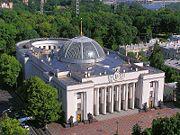
On July 16, 1990, the Verkhovna Rada of the Ukrainian Soviet Socialist Republic approved the Declaration on Ukraine’s State Sovereignty, marking the first step toward comprehensive reform of Ukraine’s political and constitutional framework. The path was thus open for Ukraine to proclaim its independence on August 24, 1991. This day has been celebrated since then as Independence Day.
The President of Ukraine is the head of the state and speaks on behalf of it. He is elected by universal, equal and direct suffrage by secret ballot for the term of five years and not more than for two successive terms. Leonid Kravchuk was the first president of the state. On July 10, 1994 Leonid Kuchma was elected the President of Ukraine. Today Victor Yushchenko is the head of our country.
The executive power is exercised by the Cabinet of Ministers. It is responsible to the President and is accountable to the Verkhovna Rada. The Cabinet of Ministers carries out domestic and foreign policy of the state, the fulfilment of the Constitution, as well as the acts of the President, develops and fulfils national programs on the economic, scientific, technological and cultural development of Ukraine.
The highest body of legislative power is the Verkhovna Rada (a single chamber national parliament). The parliament provides seats for 450 people’s deputies elected for the term of 4 years. The main function of our Parliament is making laws.
Ukraine is a republic and administratively it consists of 24 regions (oblasts) and the Autonomous Republic of the Crimea. The capital of Ukraine is Kyiv. The other big cities are Kharkiv, Dnipropetrovsk, Donetsk, Odesa and many others. Ukraine is a country of immense potential, abundant in human and natural resources. It possesses a well-educated population, a strong backbone of industry and infrastructure.
EXERCISES
Exercise 1. Answer the questions.
1. What is the largest country in Europe?
2. What is considered to be the geographical centre of Europe?
3. What is Ukraine like?
4. How large is Ukraine?
5. What resources is the country richly endowed by nature?
6. What are the main branches of industry in Ukraine and why ?
7. How are the agro and forestry resources used in Ukraine?
8. What mountains are situated on the territory of Ukraine?
9. What are Ukrainian forests famous for?
10. What is the animal world like?
11. What is the longest river of Ukraine?
12. What are the lakes in Ukraine?
13. What is the climate in Ukraine?
14. What is the population of the country?
15. What is the state language of Ukraine?
16. What are the national Ukraine’s symbols?
17. What was the first step toward comprehensive reform of Ukraine’s political and constitutional framework?
18. What is the role of the President in Ukraine?
19. How many presidents were there in Ukraine?
20. What are the functions of the Cabinet of Ministers?
21. What is the highest body of legislative power?
22. What is the administrative division of Ukraine?
Exercise 2. Translate from English into Ukrainian.
-
Ukraine is a wondrous land of spectacular scenic beauty, a land of shady woods and rolling hills, glittering lakes and deep blue seas, soaring mountains and tranquil estuaries.
-
The country is richly endowed by nature, possessing large deposits of iron ore, manganese ore, titanium, granite and marble.
-
Ukraine is blessed with potentially rich agro and forestry resources, most of which are used in agriculture and timber industry.
-
In the animal world of the Crimean Mountains we can find rare birds and animals like carrion eagle, black griffon, red deer.
-
The national symbols of Ukraine are the blue and yellow National Flag, the Ukrainian Anthem and the National Emblem – a trident.
-
On July 16, 1990, the Parliament of Ukrainian Soviet Socialist Republic approved the Declaration on Ukraine’s State Sovereignty, marking the first step toward comprehensive reform of Ukraine’s political and constitutional framework.
-
The Cabinet of Ministers carries out domestic and foreign policy of the state, the fulfilment of the Constitution, as well as the acts of the President, develops and fulfils national programs on the economic, scientific, technological and cultural development of Ukraine.
-
Ukraine is a country of immense potential, abundant in human and natural resources. It possesses a well-educated population, a strong backbone of industry and infrastructure.
Exercise 3. Translate from Ukrainian into English.
-
Україна – найбільша країна в Європі. Вона простягається на 1.300 км від Карпат на заході до степів на сході, і на 900 км від боліт на півночі до Азовського та Чорного морів на півдні.
-
Найдовша річка України – Дніпро, що розділяє країну на правобережну та лівобережну. Її вважають третім за довжиною водним шляхом у Європі.
-
Клімат в Україні – помірно-континентальний, що означає холодну та сніжну зиму та тепле сонячне літо.
-
Населення України – 47 мільйонів. Це багатонаціональна держава.
-
Тризуб – національний символ України. Це найдавніший та найвеличніший з усіх українських символів.
-
Таким чином був відкритий шлях до проголошення Україною незалежності 24 серпня 1991 року.
-
Найвищим органом законодавчої влади є Верховна Рада (однопалатний парламент), що надає місця 450 народним депутатам, що обираються на 4- річний термін.
-
Україна адміністративно ділиться на 24 області та Автонoмну Республіку Крим.
Exercise 4. Read and dramatize the following dialogues:
A: What country are you from?
B: I’m from the USA and Mr. Smith is from England.
A: Are you travelling together?
B: Yes, we are members of a tourist group.
A: Have you visited many places in Ukraine?
B: Quite a lot. We have been to Odesa, Kharkiv and the Crimea.
A: Have you been to the capital?
B: Not yet. We are going there now.
A: That’s fine. Kyiv is really worth seeing.
* * *
A: I’m from Wales. And you? Are you Russian?
B: No, I am Ukrainian. My name is Petrenko.
A: Glad to meet you Mr. Petrenko.By the way I’m going to visit your country soon.
B: Really? When?
A: In a week. I shall go by plane to Kyiv and by bus throughout Ukraine.
B: That’s fine. I like travelling by bus. One can see more of the country.
A: I am going to see typical Ukrainian villages and large industrial and cultural centres.
B: Then you should go to Kyiv, the capital of Ukraine. It is one of the most ancient and beautiful not only Ukrainian, but also European cities. And typical villages are situated in the western part of the country.
A: Thank you for your valuable advice.
A: I am going to visit Ukraine. Could you tell me what language is spoken there?
B: Ukrainian, of course.
A: I speak Russian a little. Will they understand me?
B: Yes, they will. Many people in Ukraine know Russian as well.
A: Thank you. But do they speak English?
B: Young people do. They speak English quite well.
A: That’s great. I hope to find there a lot of new friends.
B: Good luck.
Exercise 5. Make up your own dialogues using the following expressions:
sovereign state, proclaim, total area, population, rich deposits of iron, metals, coal, the geographical position, higher and local bodies of state power, national emblem, high mountains, vast steppes, beautiful rivers, the flora and fauna.
Communicative situations
-
You are for the first time in Ukraine. You speak with your guide.
-
You tell your people at home about your visit to Ukraine.
KYIV
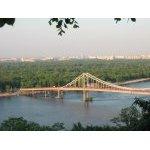
Glorious-славетний, розкішний
to span-охоплювати
magnificence-пишнота, розкіш
splendor-розкіш, пишнота
to enthral-зачаровувати, захоплювати
to honour-шанувати, поважати
matrimonial ties-шлюбні зв’язки
genesis-походження, виникнення
antiquity-стародавність, античність
to reign-царювати
to commence-починатися
majestic-величний
heritage-спадщина
incipient-що з’являються
tremendous-величезний, приголомшливий
to enthrone-садити на престол
to heal-виліковувати
exquisite-відмінний, винятковий, вишуканий
elaborate-детально розроблений, дуже складний
to float-пливти
to embroider-вишивати
garment-предмет одягу, одежина
ceramics-кераміка, гончарне виробництво
wood carving-різблення по дереву
to appreciate-цінувати, визнавати
inferior-поступливий
Kyiv is the capital of Ukraine. It is one of the most ancient European cities. Its glorious history spans more than 1,500 years. There is a legend about founding of Kyiv. Once there lived three brothers Kyi, Shchek and Khoriv and their younger sister Lybed. They founded a city on the picturesque hills of the Dnipro river and called it Kyiv after the eldest brother. From olden times it is referred to as ‘the Mother of all cities of ancient Rus’. The magnificence and splendor of Kyiv’s Golden Domes have enthralled visitors for centuries. From the 11th century, a time of prosperity for the Kyiv Rus state, many European kings considered it an honour to establish matrimonial ties with the family of the Grand Prince of Kyiv.
Kyiv’s breathtaking religious and cultural architectural monuments date their genesis in antiquity to the first half of the 11th century, during the reign of Grand Prince Yaroslav the Wise (982-1054), who extended the borders of the ancient city and commenced creation of majestic architectural heritage. The main entrance to the city then was the Golden Gate. Unique incipient monasteries, cathedrals and palaces became the evidences of Kyiv Rus prosperity. The St. Sophia’s Cathedral appeared to be the huge, monumental and wondrous construction, crowned with thirteen gilded domes rising proudly to the skies, decorated with frescos, tremendous due to their expressiveness, and multicoloured mosaics. It was the place, where princes were enthroned, foreign ambassadors were received and agreements were signed. The first library in Rus was founded here.
The monastery ensemble, Kyiv-Pechersk Lavra, also dates back to the 11th century. The experts assure that just visiting the unique Kyiv Pechersk Caves can heal various diseases. Among the museums of Lavra is the museum of Ukrainian Folk Decorative Art, which comprises more than 50,000 exhibits.
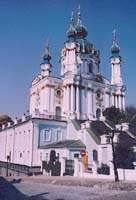
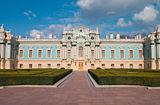
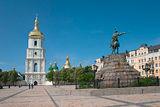
For over two centuries St. Andrew church, an outstanding creation of the famous architect B. Rastrelli has delighted all who see it with its exquisite forms, elaborate interior and exterior design and original location. When you look at it from the ancient Podol District, it seems to be floating in the air. Now it is a functioning church and a branch of the St. Sophia’s Museum. It contains an exhibition devoted to the history of the church and the work of Rastrelli. This light and graceful church, magnificent and refined Mariinskyi Palace and many other historical monuments became the decorations of the modern city. The monuments to outstanding people such as Prince Volodymyr, who introduced Christianity in Ukraine, Bohdan Khmelnytsky, the first Hetman of the State, Taras Shevchenko, the bard of freedom, talented Ukrainian poet and painter, decorate the city.
Kyiv’s cultural life is rich and varied. Numerous museums attract attention of their visitors by rare exhibits. The most interesting museums are the Museum of Ukrainian Applied Art with a large collection of embroidered garments, towels, ceramics and wood carving, the Historical museum, the T. G. Shevchenko museum, the Museum of Eastern and Western Art, etc.
Kyiv’s theatres are known not only in Ukraine. The famous National Opera, the Ivan Franko Ukrainian Drama Theatre, the Lesya Ukrainka Russian Drama Theatre are greatly appreciated by Kyiv audience and guests from other towns and countries.
Kyiv is one of the most important educational and scientific centres of the state. There are hundreds of secondary and specialized schools, gymnasiums and lyceums. Among the famous higher educational establishments are the National Ukrainian University named after Shevchenko, the National Technical University of Ukraine ‘Kyiv Polytechnic Institute’, the Kyiv-Mohyla Academy and many other academic and research institutions. The Academy of Sciences of Ukraine is located in the capital.
Kyiv is also a major industrial centre with enterprises and firms engaging in electronics, instrument construction, aviation, engineering and metal-working. Food processing, metallurgy, chemicals, building materials and textiles are important industries in the city.
The political centre of the state is Kyiv. The residence of the President of Ukraine is here. It is also the seat of the Ukrainian Parliament, the Cabinet of Ministers, the Supreme and Constitutional Courts. The most important political events take place in the capital.
There are some fine bridges over the Dnipro in Kyiv. The most interesting of them is the Paton Bridge named after the outstanding Ukrainian scientist and academician Yevgen Paton. This is the first all-welded bridge in the world.
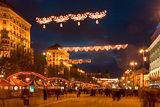
The main avenue of the capital is Khreshchatyk. It is the soul of the city with the unique buildings. The architectural effect is intensified by the leafy chestnut trees lining the street. It is the people’s favourite place for public holidays.
Kyiv of today is inferior to no other city in its beauty and originality. One can compare it with any other European capital.
EXERCISES
Exercise 1. Answer the questions.
-
What is the capital of Ukraine?
-
How old is Kyiv?
-
What does the legend about its founding say?
-
What have enthralled visitors of ‘the Mother of all cities of ancient Rus’ for centuries?
-
What did many European kings consider the greatest honour?
-
What did Yaroslav the Wise do for the prosperity of the city?
-
What is the St. Sophia’s Cathedral famous for?
-
Why does the monastery ensemble Kyiv-Pechersk Lavra attract tourists’ attention?
-
What has St. Andrew church delighted all who see it with for over two centuries?
-
What monuments became the decorations the modern city?
-
What are the most interesting museums of Kyiv?
-
What theatres is Kyiv famous for?
-
Why is Kyiv one of the most important educational and scientific centres of Ukraine?
-
What branches of industry are well-developed in the city?
-
What is the political centre of the state?
-
What is the first all-welded bridge in the world?
-
What is the soul of Kyiv and why?
-
Kyiv of today is inferior to no other city in its beauty and originality, isn’t it?
Exercise 2. Translate from English into Ukrainian.
-
Kyiv’s breathtaking religious and cultural architectural monuments date their genesis in antiquity to the first half of the 11th century, during the reign of Grand Prince Yaroslav the Wise, who extended the borders of the ancient city and commenced creation of majestic architectural heritage.
-
The St. Sophia’s Cathedral appeared to be the huge, monumental and wondrous construction, crowned with thirteen gilded domes rising proudly to the skies, decorated with frescos, tremendous due to their expressiveness, and multicoloured mosaics.
-
For over two centuries St. Andrew church, an outstanding creation of the famous architect B. Rastrelli has delighted all who see it with its exquisite forms, elaborate exterior and interior design and original location. When you look at it from the ancient Podol District, it seems to be floating in the air.
-
Kyiv’s cultural life is rich and varied. Numerous museums attract attention of their visitors by rare exhibits. The most interesting museum is the Museum of Ukrainian Applied Art with a large collection of embroidered garments, towels, ceramics and wood carving.
-
Kyiv is also a major industrial centre with enterprises and firms engaging in electronics, instrument construction, aviation, engineering and metal-working. Food processing, metallurgy, chemicals, building materials and textiles are important industries in the city.
-
Khreshchatyk is the soul of the city with the unique buildings. The architectural effect is intensified by the leafy chestnut trees lining the street.
-
Kyiv of today is inferior to no other city in its beauty and originality. One can compare it with any other European capital.
Exercise 3. Translate from Ukrainian into English.
-
Київ – столиця України. Це одне з найбільш стародавніх Європейських міст. Його славетна ісорія охоплює більше ніж 1.500 років.
-
Жили-були три брата Кий, Щек і Хорив і їхня молодша сестра Либідь. Вони заснували місто на мальовничих пагорбах річки Дніпро та назвали його Києвом на честь старшого брата.
-
Головним входом до міста тоді були Золоті ворота. Унікальні монастирі, собори ти палаци, що з’явились тоді стали доказом розквіту Київської Руси.
-
Софіївський собор був місцем де саджали на престол князів, приймали іноземних послів та підписували угоди.
-
Експерти запевняють, що лише відвідування унікальних печер Києво-Печерської Лаври можуть виліковувати різні хвороби.
-
Ця легка та витончена церква, розкішний та вишуканий Маріїнський палац і багато інших історичних пам’ятників стали прикрасами сучасного міста.
-
Знаменита Національна опера, театр Української драми ім. І. Франка, театр Російської драми ім. Л. Українки високо цінуються київською публікою та гостями з інших міст і країн.
-
Київ – політичний центр держави. Тут знаходиться резиденція Президента України. Це місцезнаходження Українського Парламенту, Кабінету Міністрів, Верхорного та Конституційного судів.
Exercise 4. Read and dramatize the following dialogues:
A: Hello, I’m so glad to meet you! I don’t have any friends in this city. What’s there to see here?
B: We have many places of interest here. Every part of the city has something interesting or beautiful. I have my car at the door of the hotel. Let me take you around. This is Khreshchatyk. It’s the main street of the city. There are apartment houses, shops and government offices here.
A: How long is it?
B: It’s relatively short. It’s only 1,200 metres long.
A: And what is that building?
B: It’s the City Council.
A: And that building on the left?
B: That’s the Pinchuk Art Centre. It is open now and you can go to see a very interesting exhibition there.
A: Thank you. But what historical places are worth seeing in Kyiv?
B: First of all you should see the Golden Gate, the St. Sophia’s Cathedral and
St. Andrew church, an outstanding creation of famous architect B. Rastrelli. You will get an unforgettable impression.
* * *
A: Sorry. I am a stranger in Kyiv and I’ve lost my way. Can you tell me the way to the Museum of Ukrainian Art?
B: Sure. Go straight ahead. At the roundabout turn right. You will see the museum in front of you.
A: Wouldn’t it be better for me to go there by trolleybus?
B: No. You can take a number 20 bus.
A: What is Kyiv famous for?
B: In fact, it is an ancient city and it is famous for its historical places.
A: What would you recommend me to see first?
B: The monastery ensemble – Kyiv-Pechersk Lavra. It dates back to the 11th century.
A: Thank you for your advice. I’ll go there now.
Exercise 5. Make up your own dialogues using the following expressions:
glorious history, legend, breathtaking religious and cultural monuments, majestic architectural heritage, cathedral, museums, church, cultural life, theatres, educational and scientific centre, enterprises and firms, political centre, people’s favourite place.
Communicative situations
-
Imagine you are in Kyiv. What are your impressions?
-
You have visited Ukraine and your friend is interested in cultural life in Kyiv. What would you say?
GREAT BRITAIN


Constitutional monarchy – конституційна монархія
to command – панувати, мати в своєму розпорядженні, володіти
legislative authority – законодавча влада
to exercise - здійснювати
rural dwellers – сільські мешканці
county - графство
gently – ніжно, лагідно
sloping surface – похила, спадиста поверхня
arable land – орна земля
pasture - пасовища
stuff – матеріал, тканина
loch - озеро
stream - струмок
harbour – гавань, порт
mouth - гирло
tide – морський приплив і відплив
tributary - приток
wheat - пшениця
barley – ячмінь
oats - овес
herring - оселедець
Stock Exchange – фондова біржа
